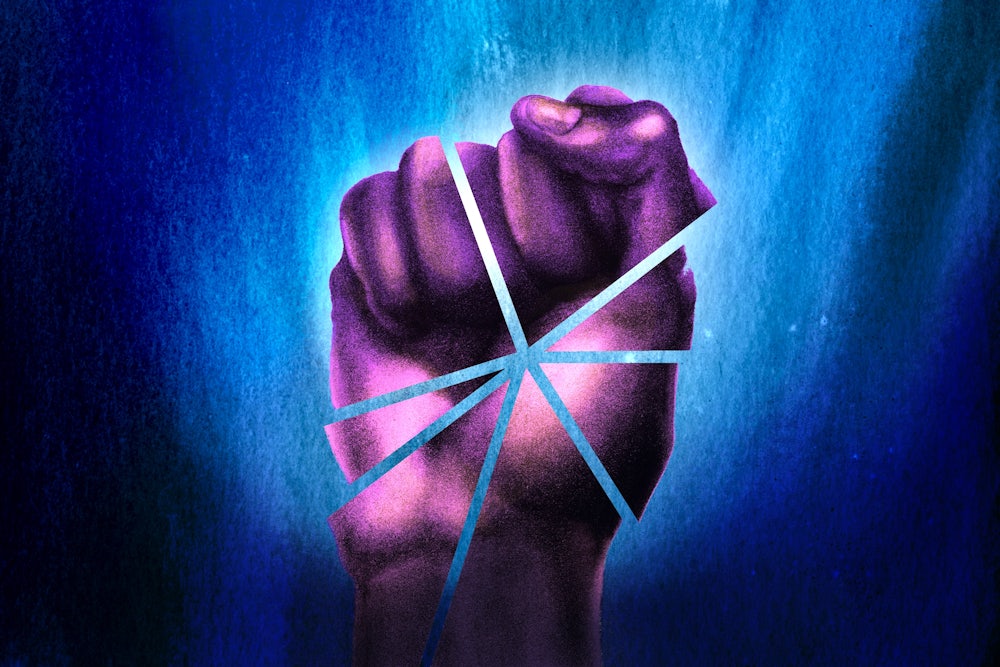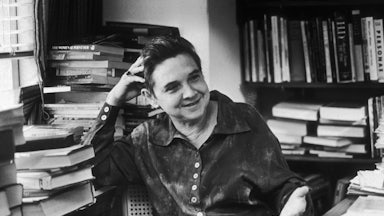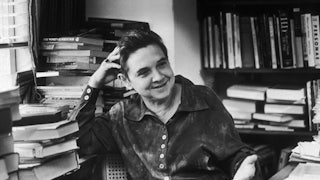One night last summer, I saw a police van go up in flames, and I allowed myself to feel hope, something that had become quite foreign to me after the year’s many stupefying months. For a number of us who went out in the aftermath of George Floyd’s murder and the sacking of the third precinct in Minneapolis, it was the first time we had encountered our friends with bigger fears than our breath. “When someone put their arms around me to pull me out of the way of a swinging baton, that still counts as an embrace,” I joked at the beginning of June. The speed and force with which the rebellions multiplied across the country triggered, surprisingly, an outpouring of support. Faced with a recurring display of police repression and lacking leaders to negotiate with, broad swathes of American society fell in line, either joining the protests themselves or, in the case of many corporations, donating large sums to various Black organizations. By July, the marches were still going, but the heat of the uprisings had dissipated. In these days of blacked-out Instagram squares and “Black Lives Matter” painted on city streets, a cry went up—listen to Black people. In most cases I prefer to be heard when I speak, but there are some 47 million of us now. It would have been prudent to specify which ones.
As other cities calmed, Portland, Oregon, was one of the few holdouts of near daily militant confrontations with the police as well as federal agents. E.D. Mondainé, then the president of the local NAACP chapter, wrote an op-ed for The Washington Post castigating his “white brothers and sisters” for having given in to the temptation of spectacle and strayed from the original mission, which was, in his eyes, “redeeming a guilty nation.” He name-checked the so-called “naked Athena,” who sat nude before a line of police officers, and the “Wall of Moms,” a group of mostly white mothers who attempted to offer some protection by linking arms and standing between the protesters and federal forces. Their gambit did not work; the moms were tear-gassed like everybody else. Mondainé’s real target was not this smattering of highly visible white women. He asked, “What are antifa and other leftist agitators achieving for the cause of black equality?” He accused them of unwittingly playing into Trump’s hands, providing an image of chaos that could only be ended by a crackdown. Mondainé did a brief media blitz around his editorial. The white protesters needed to “stand behind our voices,” he told NPR. As a leader in the NAACP, he was not questioned as to the political bent of his voice and whether it was in unison with all the others. Nobody asked him what it implied about his politics if the “leftist agitators” were somehow alien to him. He was an official in the most venerated Black organization in the country. That was enough to assume that he spoke for Black people against white excess. In the fall, Mondainé resigned under pressure from his position at the NAACP, after violating its bylaws by endorsing the mayor of Portland in his reelection campaign, along with a raft of allegations concerning sexism, abuse, and financial improprieties.
For anyone who cared to look, the last decade’s cycle of uprisings and protests has indexed more than a confrontation with white supremacy; it has been the most explosive articulation of a crisis in Black politics. Representation has become a buzzword, but at the same time that media workers insist upon its necessity, the actual class of Black politicians who are thought to represent Black people politically have found that looking like is no longer sufficient. The integration of municipal, state, and federal governments has not dampened Black rage in the face of police impunity so much as it has illustrated the glaring incapacity of these political bodies to provide redress. A Black protester can now be attacked by Black cops and denounced by Black mayors. All those faces looking down at her were supposed to fulfill the promise of emancipation, but the presumed bond between their own freedom, contested and contingent as it is, with the collective one is splintering. “Go slow now,” William Faulkner once cautioned. “Don’t test us,” Lori Lightfoot once threatened. “Which side are you on, my people?” protesters asked in city after city.
Keeanga-Yamahtta Taylor wrote last year that, mired in a recession and in the wake of the civil rights movement, “black elected officials were seen as managing the crises in black working class communities, instead of leading efforts to root them out.” The marked popularity of President Obama, followed by its inverse with his successor, obscured the fact that in many cities, Black protesters have gone up against a Black political establishment. The day after CNN’s Atlanta headquarters were defaced by a group of protesters, Mayor Keisha Lance Bottoms tried to bridge the divide. She claimed she understood their widespread pain, because she was a Black mother, but repudiated their tactics: “If you care about this city, then go home and pray that somebody like Reverend Beasley will come and talk to you and give you some instructions on what a protest should look like. And how you effectuate change in America.” The speech caught then-candidate Biden’s attention, and rumors swirled for some time that she might be offered a position as his running-mate or in his Cabinet. Bottoms mentioned George Floyd but had nothing to say about Atlanta’s own history of police brutality and killings, including one during her tenure when a local activist was shot by a cop whose body camera was turned off. She focused squarely on the protesters, telling them, “You’re not honoring the legacy of Martin Luther King Jr. and the civil rights movement.” Her final words were simple, “Go home.” Less than two weeks later, an Atlanta police officer shot and killed Rayshard Brooks, a Black man who had fallen asleep in his car in a Wendy’s drive-thru. The protesters did not go home.
The invocation of the civil rights movement has become shorthand for those who wish to denigrate the current movement. Where that one was stately, this one is unruly; where that one had disciplined strategy, this one is violent improvisation; where that one had charismatic leading men, this one does not. It’s a neat fable. Accounts of the Southern Christian Leadership Conference’s Birmingham campaign epitomize this genre. This story ends on May 10, 1963, with the city’s agreement to desegregate public spaces. But on May 11, the Ku Klux Klan bombed the hotel where Martin Luther King Jr. had been staying, and the city erupted: Buildings burned, a police officer was stabbed, and when one of King’s assistants addressed the crowd and asked them to stop tossing bricks, the crowd shouted back, “They started it!” All of this must be excised in contemporary retellings. The idea that nonviolence, even in its true practice rather than the benighted passivity many mistake it for, is the only route to emancipation has never fit squarely with the fact that Black Americans’ first brush with freedom en masse came through the conflagration of the nation’s most devastating war. Better, when possible, to pretend that the violence hasn’t happened. The truncated version of the civil rights movement that predominates today sowed the seeds for the careers of many Black elected officials. As the years wore on, these officials benefited from the moral authority bestowed upon them by their participation in the struggle so long as the memory of its methods could be kept pure.
The Congressional Black Caucus, named as such in 1971, has adopted the descriptor “the conscience of Congress,” and no one personified this more than the late John Lewis. He was an organizer of the March on Washington and was beaten on Bloody Sunday. Yet one effect of the simplification of that period of struggle has been a false memory of political unity. When Lewis first ran for Congress, he wound up in a runoff against Julian Bond, an erstwhile ally and one of the founders of the Student Nonviolent Coordinating Committee. Bond was more famous at the time but knew that he would have trouble with some voters because he had publicly expressed his admiration for draft-card burners. Moreover, he “had the reputation of being a race man,” he told Atlanta Magazine in 1990. He surmised that white voters would assume that once elected he would focus on the interest of his Black constituents more than his white ones. “That was a correct analysis for them to have,” he said. “They were right.” Bond won a majority of the Black vote, but he did not win the seat.
It is owed to the pervasiveness of racism as a fundamental tool of political analysis that any Black person who utters the word “freedom” can be portrayed as a radical, and any Black politician can be thought a representative for their race rather than their political principles. This has forced many of them into a difficult dance. They call on a tradition of Black radicalism that they may have benefited from but of which they are not truly inheritors.
In Atlanta last summer, Bottoms reminded her listeners that her city “has had a legacy of Black mayors and Black police chiefs.” It wasn’t an entirely helpful fact to remark upon, since such a history might be used as counterevidence to the ready-made reform of altering the racial makeup of a given city’s police department. If they had such a legacy then the problem might be bigger than reformers have assumed and might require new methods and new demands. As James Forman Jr. detailed in Locking Up Our Own, a history of the early Black support for the “war on crime,” Atlanta’s civil rights groups had long campaigned for the hiring and promotion of Black police officers. The Commission on Interracial Cooperation, which “brought together southern white liberals and conservative blacks,” was one of the more prominent organizations in the prewar years. Its composition highlights the problem of the blanket demand to “listen to Black people.” For much of America’s history, the white liberal who chose to do so was likely to pick a conservative voice. Although wealth and institutionalized religion are frequently portrayed as conservative forces, little thought is given to the prominence of the middle and upper classes or the Black clergy among the ranks of “mainstream” Black leaders. The CIC, comprising such elements, believed that “black officers would be capable of distinguishing among classes and types of blacks,” Forman writes. One of the signal issues for these organizers in diversifying the department was that they were being lumped in with “gamblers and known harlots.” It wasn’t quite freedom Black cops were supposed to provide; it was privilege. Sex workers or young men shooting dice would get what was coming to them.
The belief that a cadre of Black officers would improve police behavior ran aground on the shores of the labor market. Forman writes that the “new black officers saw policing as a job, not as another front in the civil rights movement.” While abolitionists envision a redistribution of services, since the days of the CIC policing has in effect been a jobs program. That changing the demographics of various departments has not altered the fundamental relationship between Black communities and the police is beside the point. When local Black politicians on the right flank of the Democratic Party come out against the central demands of the current protest movement, they tend to recast a political disagreement in abstracted racial terms.
During the debates about cutting the NYPD’s budget last summer, Brooklyn Councilwoman Laurie Cumbo claimed that “defund the police” was a “colonization” of the movement by white progressives. Cumbo has taken to tying Black opponents on her left to purportedly white interests. She dismissed Jabari Brisport, a Democratic Socialists of America–backed state senator, as a product of a gentrification movement. Brisport responded that the true gentrifiers were the real estate interests, while pointing out that Cumbo was backed by the Real Estate Board of New York in her first run for City Council. The language of Black politics in the post–civil rights era does not allow this fight to be expressed as it really is—a confrontation between the right and left wings of the party. Instead, it is rerouted through the terrain of an authentic Blackness, where one is the heir to the struggle and the other an interloper. Perhaps it is a bitter symbol of how far we have come that the positions have been inverted since Julian Bond and John Lewis’s battle in the 1980s. Now the right flank of Black politics tars its enemies with claims of working for white interests.
The resurgence of Black radicalism threatens to topple the settled memory of how civil rights were won. In doing so, it menaces the rhetorical foundations of the Black establishment. The infamous photograph from Little Rock of segregationists holding aloft signs that read “Race Mixing Is Communism” is routinely deployed as an indicator of the sheer lunacy bred by the melange of Cold War hysteria and white racism. For much of the twentieth century it was also true. Communists assisted in the defense of the Scottsboro Boys, and a Communist wrote the anti-lynching song Strange Fruit. In Defying Dixie: The Radical Roots of Civil Rights, historian Glenda Elizabeth Gilmore quotes a representative of the American Federation of Labor who argued that racial equality “created a state of mind … which was hostile to the workers,” at a time when a Communist union had begun organizing Black and white textile workers. In 1943, in the wake of riots sparked by a police officer shooting a Black man, Harlem elected Ben Davis to replace Adam Clayton Powell Jr. in the City Council. Davis was the candidate of the Communist Party and would hold the seat until he was prosecuted under the Smith Act. Once convicted, he was defeated by a man who had been endorsed by both the Republicans and the Democrats. The careful delineation of what Bayard Rustin termed the “classical stage” of the civil rights movement allowed the creation of a Black politics that calls upon this legacy without having to admit the uncomfortable truth that the Black struggle has often been inextricable from the leftist one. “Communism,” Ben Davis once said, “is twentieth-century Abolitionism.” Here we are, in a new century, and that word is ringing out again.
In October 2014, the president of the NAACP was shouted down while orating from a stage in Missouri. The crowd demanded that the organization, which had not been the driver of the Ferguson movement, cede the microphone to the people who had. Tef Poe, a local organizer and musician, got up on stage and shouted, “This ain’t your daddy’s civil rights movement.” This should have been sufficient to prevent the next seven years of obfuscation about the position of the real movement in the streets with respect to its caretakers in office. Black politicians have found themselves increasingly out of step as the degree of militancy has ratcheted up, such that they regularly attempt to act as brakes. Shortly after last year’s presidential election, Representative Jim Clyburn was basking in the glow of his position as kingmaker. His endorsement had helped save Biden’s primary campaign and unleashed a torrent of political analysis about Black people’s role as a conservative check on liberal ambitions, even though exit polls indicated that Black voters were similar to most other kinds of voters: Older people broke for Biden and younger ones for Bernie Sanders. Still, Clyburn took a moment during the victory lap to tell CBS News that the summer’s most salient demand—defunding the police—was “killing our party, and we’ve got to stop it.” Clyburn warned that the slogan “could undermine the BLM movement, just as ‘burn, baby, burn’ destroyed our movement back in the ’60s.” In Life Magazine, that phrase was attributed to a “soot smudged Negro” who “appeared exhausted yet strangely exhilarated” just before dawn after the first night of the 1965 Watts riots. If Clyburn believes that utterance killed the movement, then it was dead before King was, dead before Muhammad Ali refused the draft, and dead before Clyburn himself became involved in politics. The congressman said that supporters of the slogan had pushed Lewis out of his role as chair of the Student Nonviolent Coordinating Committee. There is no mention in the article that Kwame Ture, then known as Stokely Carmichael, was chosen to replace him in May 1966. Only two months later, after the assassination of James Meredith, the new chairman emerged from a Mississippi jail and popularized the phrase that would become the rallying cry of this postclassical struggle: Black power.
The gulf between Black officials and the demands of those in the streets is not just an issue of the grinding pace of electoralism. There is a disconnect in orientation and analysis. In 2014, the Congressional Black Caucus reaffirmed its unwavering support for Israel only a short while before protesters in Missouri began chanting “From Ferguson to Palestine,” after Palestinians offered advice for how to deal with the effects of tear gas. This more or less recapitulated the split between the civil rights and Black power wings of the movement in the late 1960s. Black leftists are a minority of a minority. That their positions are not yet broadly popular is irrelevant within the context of Black politics. Black radicals tend to become popular, if they do at all, only once they are dead and their ideas have been synthesized with a narrative of inevitable American progress. Black politicians have still depended on the impression that they are the proper stewards of this lineage. That is a more difficult argument to make now that there are vibrant and dispersed networks of militants who do not answer to the beck and call of gifted orators standing before vast crowds.
Last summer, a self-appointed leader stared down a few rows of cops and began shouting, “Take a knee.” The chant had spread across the country in the mistaken belief that such a short performance would help heal the wounds of many centuries. I did not join this chant. Having spent many nights running from the police, the thought of starting from a kneeling position did not appeal to me. A friend of mine, no organizer, started shouting, “Quit your job.” The people around us repeated her words until they drowned out the leader’s. I would not say my friend was in charge, but nor was the man with the megaphone. The people had a mood and an analysis. They knew when something didn’t sound right.
We are on our third president since the late Edward Crawford was photographed wearing an American flag T-shirt while hurling a tear gas canister back at the police. In that time the Democratic Party has stumbled in its response. At the Democratic National Convention, Julia Louis-Dreyfus took a moment to “reaffirm the all-American values that our party and Joe Biden stand for” before handing it over to a prerecorded video of a young Black boy—the son of a congressional representative—with his hand over his heart as he recited the pledge of allegiance. Behind him, arranged like votives, were drawings of the dead, all of them Black, all of them made famous by the manner of their death. Gold disks circled their heads, perhaps to let us know that they were holy now or at least had gone to heaven. Displayed most prominently, to the boy’s right, was an image of Trayvon Martin staring straight ahead, his face surrounded by his hoodie. These people were made into martyrs, but they did not die for America—they died in it and of it. The figures in the drawings are all shown holding the iconic “I Am a Man” posters. They were used by striking sanitation workers in Memphis to insist upon their dignity. Martin Luther King Jr. had gone down there in a show of support when he was assassinated. It is a monstrous fate. Black suffering is so abstracted that a child killed in 2013 is made, in 2020, to hold a sign from 1968 as proof of the party’s commitment to “American values.” This was the offering to the movement: a Black boy, told by his father to smile, repeating the words “with liberty and justice for all” in front of evidence to the contrary.
The “I Am a Man” posters were used another time last year when hoppers, the New Orleans sanitation workers who empty the trash cans, went on strike to protest the hazardous conditions they were facing at the onset of the pandemic. All of the workers were Black. At the time of the convention, the strike was entering its third month, but the actual use of this imagery in a contemporary labor fight was not mentioned. It was enough to invoke the legacy and hold it fast, secure against the present. This, in short, is at the root of the legitimacy crisis beginning to roil Black politics. Some view a cherry-picked history as a justification for their positions; others see a great demand placed on the present. “Black thought at its best has been a vehicle for and product of analogy,” Vinson Cunningham wrote in his critique of Frank Wilderson’s narrow conception of what is possible in this world. Black thought has spoken in metaphor, and it has found allies and accomplices in other struggles. Yes, it has been betrayed and stymied, but “the impulse toward freedom is always seeking friends.”
Vincent Harding famously compared the freedom struggle to a river; there is a fork in that river now. A conservative vision of Black liberation has occupied the public imagination for decades, and it finds itself under siege from a movement that is more expansive and more internationalist than its would-be representatives can bear. In the early days of the uprisings, I felt like we were living in that break. The nights were not regrettable. They were mournful, outrageous, and beautiful. Like the man in Watts in 1965, my friends and I spoke of being exhausted and exhilarated. A chasm had been bridged, and some startlingly new realm of possibility was opened to us. A group of the young and disrespected produced, for a time, a mass multiracial movement against the police. This was not the overly engineered idyllic melting pot of a college brochure. People erred. They tend to do so during rebellions. But many watched the news or scrolled through their timelines and heard tell that people were being beaten, gassed, and even killed in these protests and then went out and joined them. The mistakes that were made were tactical, not moral. That is a break with tradition. It was good practice. The past is littered with many old things we will have to give up.




